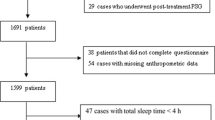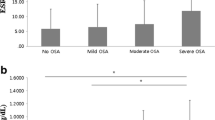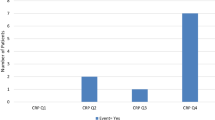Abstract
The polysomnography (PSG) index of the apnea hypopnea index (AHI) is considered the ‘gold standard’ for stratifying the severity of obstructive sleep apnea (OSA). However, AHI cannot reflect the true characteristic of chronic intermittent hypoxia (CIH), which may trigger systemic inflammation in some OSA patients. High-sensitivity C-reactive protein (hsCRP) is considered a biomarker of systemic inflammation in OSA patients. The aim of the present study was to evaluate the relationship between PSG variables and hsCRP in men with severe OSA. Men with severe OSA (AHI ≥30 events/h) diagnosed by PSG were enrolled. AHI and body mass index were matched between a high hsCRP group (hsCRP ≥3.0 mg/L) and a low hsCRP group. A blood sample was taken for serum hsCRP analysis. Multiple regression analysis was performed to assess independent predictors of high hsCRP. One hundred and fifty-two subjects were enrolled in the study (76 in each group). Mean serum hsCRP was 3.76 ± 2.13 mg/L. The mean percentage of total sleep time spent with SaO2 <90 % (TST) in the high hsCRP group was significantly higher than in the low hsCRP group (20.99 ± 18.52 vs. 5.84 ± 7.30, p < 0.001). Multivariate analysis showed that TST was the strongest predictor, contributing to 27.7 % of hsCRP variability (β = 0.496, p < 0.01). TST may be superior to AHI for evaluating CIH among OSA patients. The severity of OSA should be stratified by a combination of AHI and other hypoxia variables.
Similar content being viewed by others
References
Young T, Palta M, Dempsey J, Skatrud J, Weber S, Badr S (1993) The occurrence of sleep-disordered breathing among middle-aged adults. N Engl J Med 328:1230–1235
Douglas NJ, Polo O (1994) Pathogenesis of obstructive sleep apnoea/hypopnoea syndrome. Lancet 344:653–655
Haverkate E, Thompson SG, Pyke SDM, Gallimore JR (1997) Production of C-reactive protein and risk of coronary events in stable and unstable angina. Lancet 349:462–466
Lindahl B, Toss H, Siegbahn A, Venge P, Wallentin L (2000) Markers of myocardial damage and inflammation in relation to long-term mortality in unstable coronary artery disease. N Engl J Med 343:1139–1147
Ridker PM, Rifai N, Rose L, Buring JE, Cook NR (2002) Comparison of C-reactive protein and low-density lipoprotein cholesterol levels in the prediction of first cardiovascular events. N Engl J Med 347:1557–1565
Levy P, Pepin JL, Arnaud C, Tamisier R, Borel JC, Dematteis M, Godin-Ribuot D, Ribuot C (2008) Intermittent hypoxia and sleep-disordered breathing: current concepts and perspectives. Eur Respir J 32:1082–1095
Punjabi NM, Beamer BA (2007) C-reactive protein is associated with sleep disordered breathing independent of adiposity. Sleep 30:29–34
Lui MM, Lam JC, Mak HK, Xu A, Ooi C, Lam DC, Mak JC, Khong PL, Ip MS (2009) C-reactive protein is associated with obstructive sleep apnea independent of visceral obesity. Chest 135:950–956
Shamsuzzaman AS, Winnicki M, Lanfranchi P, Wolk R, Kara T, Accurso V, Somers VK (2002) Elevated C-reactive protein in patients with obstructive sleep apnea. Circulation 105:2462–2464
Kokturk O, Ciftci TU, Mollarecep E, Ciftci B (2005) Elevated C-reactive protein levels and increased cardiovascular risk in patients with obstructive sleep apnea syndrome. Int Heart J 46:801–809
Yokoe T, Minoguchi K, Matsuo H, Oda N, Minoguchi H, Yoshino G, Hirano T, Adachi M (2003) Elevated levels of C-reactive protein and interleukin-6 in patients with obstructive sleep apnea syndrome are decreased by nasal continuous positive airway pressure. Circulation 107:1129–1134
Akashiba T, Akahoshi T, Kawahara S, Majima T, Horie T (2005) Effects of long-term nasal continuous positive airway pressure on C-reactive protein in patients with obstructive sleep apnea syndrome. Intern Med 44:899–900
Ishida K, Kato M, Kato Y, Yanagihara K, Kinugasa Y, Kotani K, Igawa O, Hisatome I, Shigemasa C, Somers VK (2009) Appropriate use of nasal continuous positive airway pressure decreases elevated C-reactive protein in patients with obstructive sleep apnea. Chest 136:125–129
Iber C, Medicine AAoS (2007) The AASM manual for the scoring of sleep and associated events: rules, terminology and technical specifications for the American Academy of Sleep Medicine, 1st ed. American Academy of Sleep Medicine, Westchester
Chen NH, Johns MW, Li HY, Chu CC, Liang SC, Shu YH, Chuang ML, Wang PC (2002) Validation of a Chinese version of the Epworth sleepiness scale. Qual Life Res 11:817–821
Johns MW (1991) A new method for measuring daytime sleepiness: the Epworth sleepiness scale. Sleep 14:540–545
Szmitko PE, Wang CH, Weisel RD, de Almeida JR, Anderson TJ, Verma S (2003) New markers of inflammation and endothelial cell activation: part I. Circulation 108:1917–1923
Ridker PM, Stampfer MJ, Rifai N (2001) Novel risk factors for systemic atherosclerosis: a comparison of C-reactive protein, fibrinogen, homocysteine, lipoprotein(a), and standard cholesterol screening as predictors of peripheral arterial disease. JAMA 285:2481–2485
Shamsuzzaman ASM, Gersh BJ, Somers VK (2003) Obstructive sleep apnea. JAMA 290:1906–1914
Drager LF, Bortolotto LA, Lorenzi MC, Figueiredo AC, Krieger EM, Lorenzi-Filho G (2005) Early signs of atherosclerosis in obstructive sleep apnea. Am J Respir Crit Care Med 172:613–618
Steiropoulos P, Tsara V, Nena E, Fitili C, Kataropoulou M, Froudarakis M, Christaki P, Bouros D (2007) Effect of continuous positive airway pressure treatment on serum cardiovascular risk factors in patients with obstructive sleep apnea–hypopnea syndrome. Chest 132:843–851
Sharma S, Mishra HK, Sharma H, Goel A, Sreenivas V, Gulati V, Tahir M (2008) Obesity, and not obstructive sleep apnea, is responsible for increased serum hs-CRP levels in patients with sleep-disordered breathing in Delhi. Sleep Med 9:149–156
Visser M, Bouter LM, McQuillan GM, Wener MH, Harris TB (1999) Elevated C-reactive protein levels in overweight and obese adults. JAMA 282:2131–2135
Volna J, Kemlink D, Kalousova M, Vavrova J, Majerova V, Mestek O, Svarcova J, Sonka K, Zima T (2011) Biochemical oxidative stress-related markers in patients with obstructive sleep apnea. Med Sci Monit 17:CR491–CR497
Roche F, Gaspoz JM, Pichot V, Picard-Kossovsky M, Maudoux D, Garcin A, Celle S, Sforza E, Barthelemy JC, Proof, Groups SS (2009) Association between C-reactive protein and unrecognised sleep-disordered breathing in the elderly. Eur Respir J 33:797–803
Tamaki S, Yamauchi M, Fukuoka A, Makinodan K, Koyama N, Tomoda K, Yoshikawa M, Kimura H (2009) Production of inflammatory mediators by monocytes in patients with obstructive sleep apnea syndrome. Intern Med 48:1255–1262
Chung S, Yoon IY, Shin YK, Lee CH, Kim JW, Lee T, Choi DJ, Ahn HJ (2007) Endothelial dysfunction and C-reactive protein in relation with the severity of obstructive sleep apnea syndrome. Sleep 30:997–1001
Muraki I, Tanigawa T, Yamagishi K, Sakurai S, Ohira T, Imano H, Kitamura A, Kiyama M, Sato S, Shimamoto T, Konishi M, Iso H, Investigators C (2010) Nocturnal intermittent hypoxia and C reactive protein among middle-aged community residents: a cross-sectional survey. Thorax 65:523–527
Svensson M, Venge P, Janson C, Lindberg E (2012) Relationship between sleep-disordered breathing and markers of systemic inflammation in women from the general population. J Sleep Res 21:147–154
Asano K, Takata Y, Usui Y, Shiina K, Hashimura Y, Kato K, Saruhara H, Yamashina A (2009) New index for analysis of polysomnography, ‘integrated area of desaturation’, is associated with high cardiovascular risk in patients with mild to moderate obstructive sleep apnea. Respiration 78:278–284
Ryan S, Taylor CT, McNicholas WT (2005) Selective activation of inflammatory pathways by intermittent hypoxia in obstructive sleep apnea syndrome. Circulation 112:2660–2667
Greenberg H, Ye X, Wilson D, Htoo AK, Hendersen T, Liu SF (2006) Chronic intermittent hypoxia activates nuclear factor-kappaB in cardiovascular tissues in vivo. Biochem Biophys Res Commun 343:591–596
Acknowledgments
The authors appreciate the help of Bin Yang with blood sample measurement and Wen-Jin Ye with statistical analysis.
Conflict of interest
All authors have no conflicts of interest to disclose.
Author information
Authors and Affiliations
Corresponding author
Rights and permissions
About this article
Cite this article
Zhang, XB., Zen, HQ., Lin, QC. et al. TST, as a polysomnographic variable, is superior to the apnea hypopnea index for evaluating intermittent hypoxia in severe obstructive sleep apnea. Eur Arch Otorhinolaryngol 271, 2745–2750 (2014). https://doi.org/10.1007/s00405-014-3044-0
Received:
Accepted:
Published:
Issue Date:
DOI: https://doi.org/10.1007/s00405-014-3044-0




